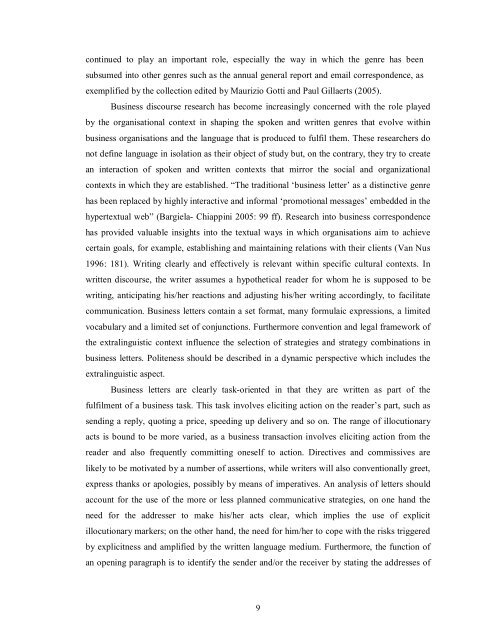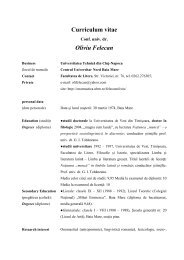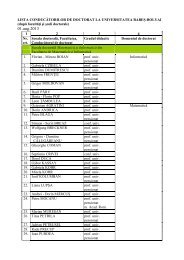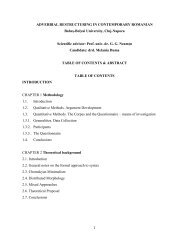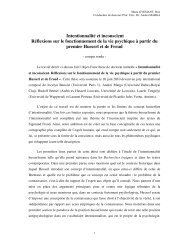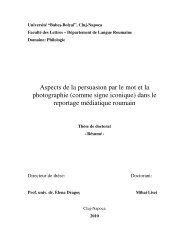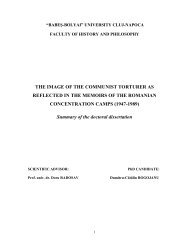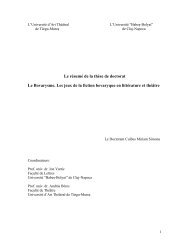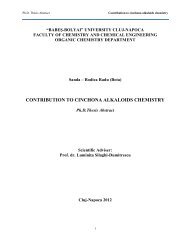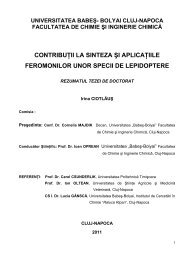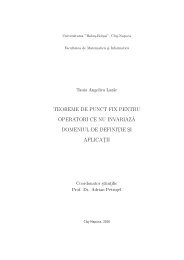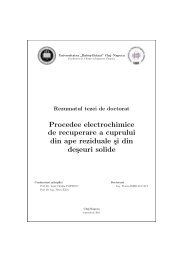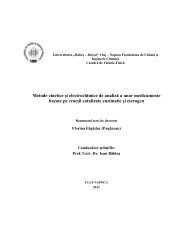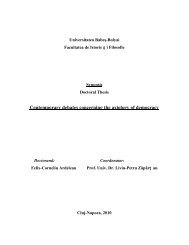1 UNIVERSITATEA “BABES –BOLYAI” CLUJ-NAPOCA ...
1 UNIVERSITATEA “BABES –BOLYAI” CLUJ-NAPOCA ...
1 UNIVERSITATEA “BABES –BOLYAI” CLUJ-NAPOCA ...
You also want an ePaper? Increase the reach of your titles
YUMPU automatically turns print PDFs into web optimized ePapers that Google loves.
continued to play an important role, especially the way in which the genre has been<br />
subsumed into other genres such as the annual general report and email correspondence, as<br />
exemplified by the collection edited by Maurizio Gotti and Paul Gillaerts (2005).<br />
Business discourse research has become increasingly concerned with the role played<br />
by the organisational context in shaping the spoken and written genres that evolve within<br />
business organisations and the language that is produced to fulfil them. These researchers do<br />
not define language in isolation as their object of study but, on the contrary, they try to create<br />
an interaction of spoken and written contexts that mirror the social and organizational<br />
contexts in which they are established. The traditional business letter as a distinctive genre<br />
has been replaced by highly interactive and informal promotional messages embedded in the<br />
hypertextual web (Bargiela- Chiappini 2005: 99 ff). Research into business correspondence<br />
has provided valuable insights into the textual ways in which organisations aim to achieve<br />
certain goals, for example, establishing and maintaining relations with their clients (Van Nus<br />
1996: 181). Writing clearly and effectively is relevant within specific cultural contexts. In<br />
written discourse, the writer assumes a hypothetical reader for whom he is supposed to be<br />
writing, anticipating his/her reactions and adjusting his/her writing accordingly, to facilitate<br />
communication. Business letters contain a set format, many formulaic expressions, a limited<br />
vocabulary and a limited set of conjunctions. Furthermore convention and legal framework of<br />
the extralinguistic context influence the selection of strategies and strategy combinations in<br />
business letters. Politeness should be described in a dynamic perspective which includes the<br />
extralinguistic aspect.<br />
Business letters are clearly task-oriented in that they are written as part of the<br />
fulfilment of a business task. This task involves eliciting action on the readers part, such as<br />
sending a reply, quoting a price, speeding up delivery and so on. The range of illocutionary<br />
acts is bound to be more varied, as a business transaction involves eliciting action from the<br />
reader and also frequently committing oneself to action. Directives and commissives are<br />
likely to be motivated by a number of assertions, while writers will also conventionally greet,<br />
express thanks or apologies, possibly by means of imperatives. An analysis of letters should<br />
account for the use of the more or less planned communicative strategies, on one hand the<br />
need for the addresser to make his/her acts clear, which implies the use of explicit<br />
illocutionary markers; on the other hand, the need for him/her to cope with the risks triggered<br />
by explicitness and amplified by the written language medium. Furthermore, the function of<br />
an opening paragraph is to identify the sender and/or the receiver by stating the addresses of<br />
9


